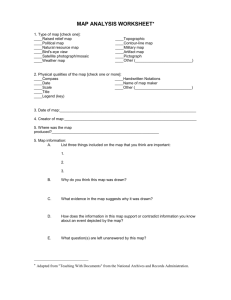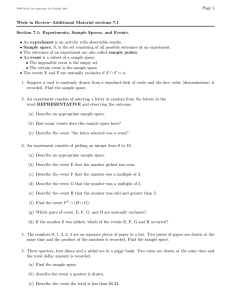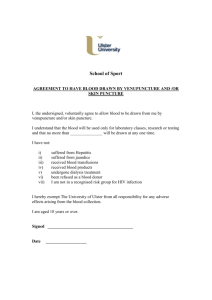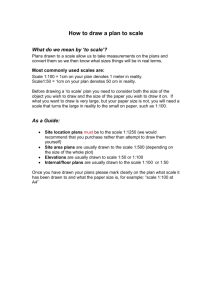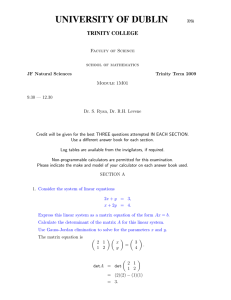UNIVERSITY OF DUBLIN TRINITY COLLEGE
advertisement
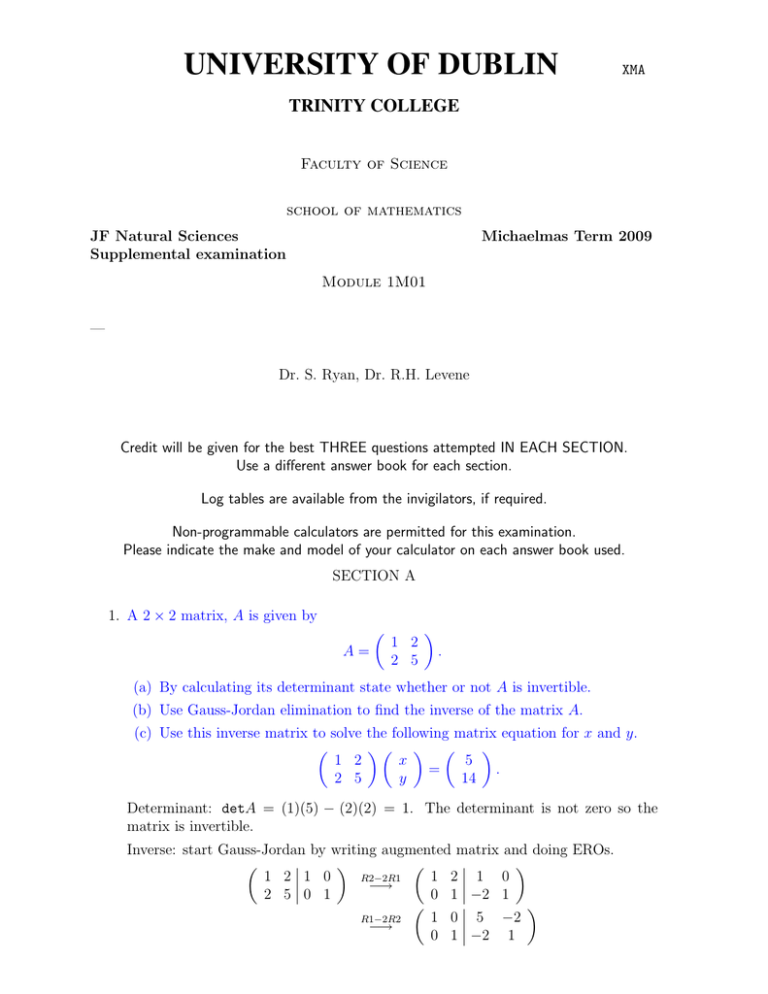
UNIVERSITY OF DUBLIN XMA TRINITY COLLEGE Faculty of Science school of mathematics JF Natural Sciences Supplemental examination Michaelmas Term 2009 Module 1M01 — Dr. S. Ryan, Dr. R.H. Levene Credit will be given for the best THREE questions attempted IN EACH SECTION. Use a different answer book for each section. Log tables are available from the invigilators, if required. Non-programmable calculators are permitted for this examination. Please indicate the make and model of your calculator on each answer book used. SECTION A 1. A 2 × 2 matrix, A is given by A= 1 2 2 5 . (a) By calculating its determinant state whether or not A is invertible. (b) Use Gauss-Jordan elimination to find the inverse of the matrix A. (c) Use this inverse matrix to solve the following matrix equation for x and y. 1 2 x 5 = . 2 5 y 14 Determinant: detA = (1)(5) − (2)(2) = 1. The determinant is not zero so the matrix is invertible. Inverse: start Gauss-Jordan by writing augmented matrix and doing EROs. 1 2 1 0 1 2 1 0 R2−2R1 −→ 2 5 0 1 0 1 −2 1 1 0 5 −2 R1−2R2 −→ 0 1 −2 1 2 So the inverse matrix is −1 A = XMA 5 −2 −2 1 and you should demonstrate this is the right answer by checking that AA−1 = A−1 A = I, the 2 × 2 identity matrix. To solve the matrix equation for x and y just multiply both sides (on the left) by A−1 . 5 −2 1 2 x 5 −2 5 = . −2 1 2 5 y −2 1 14 to get 1 0 x −3 = . 0 1 y 4 Now, just multiply the left hand side (matrix times vector) and equate with the entries in the right-hand side vector to get x = −3 and y = 4. You should also demonstrate these are correct by substituting in the original problem and seeing that they satisfy the equation. 2. (a) Write down the characteristic equation of a matrix A. (b) Consider the matrix A= 3 6 1 4 . Determine the eigenvalues of this matrix. (c) Select the largest eigenvalue and find its corresponding eigenvector. Characteristic Equation: det(A − λI) = 0. Determine the eigenvalues using det(A − λI) = 0. So, 3−λ 6 0 = det 1 4−λ = (3 − λ)(4 − λ) − (6)(1) = λ2 − 7λ + 6 = (λ − 1)(λ − 6) So the eigenvalues are λ = 1 and λ = 6. Find the eigenvector for λ = 6, using Av = λv. 3 6 v1 v1 =6 1 4 v2 v2 Multiplying out both sides gives 2 equations in v1 and v2 3v1 + 6v2 = 6v1 v1 + 4v2 = 6v2 Simplfying these you see that you have just one equation relating v1 and v2 ie v1 = 2v2 and any choice that satisfies this is an eigenvector eg (2, 1). 3 XMA 3. Consider the following experiment. A box contains five tickets labelled 0 , 0 , 0 , 0 , 1 Six tickets are drawn randomly from this box with replacement. That means that a ticket is drawn, observed and then replaced before the next ticket is drawn. (a) Explain why this is a binomial experiment. (b) Find the probability that the sum of the six tickets drawn is 2. (c) What is the expected value, E(X) for this experiment? First note that this is a binomial experiment since (a) there are a fixed number of trials (six) (b) each trial can be characterised a success (ie a 1 is drawn) or a failure (ie a 0 is drawn) (c) the probability of success for each trial is the same P(draw a 1) = 1/5 = 0.2 = p and finally (d) the central problem is counting the number of successes that occur since the sum of tickets is 2 only if exactly 2 1 tickets are drawn. Now, let X be the number of 1s that are drawn. The X has binomial (6,1/5) distribution ie n = 6, p = 0.2 and therefore q = 1 − p = 0.8 and n P (X = 2) = pk q n−k k 6 = (0.2)2 (0.8)6−2 2 = (15)(0.04)(0.4096) = 0.24576. The expected value, E(X) is just np. So E(X) = np = 6(0.2) = 1.2. 4. (a) Write down the addition and multiplication rules for probabilities. (b) State the principle of equally likely outcomes. (c) Consider four job openings for which there are eight applicants. Five are men and three are women. If all candidates are equally likely to be chosen what is the probability that no women are chosen? The first 2 parts are from the notes. For the problem: the probability that no women are chosen can be calculated by P (nowomenchosen) = P (allmenchosen) 5 4 3 2 × × × = 8 7 6 5 1 = 14 = 0.07142 or an ≈ 7% probability that no women are chosen. 4 XMA SECTION B √ 1+ x 5. (a) What is the domain of the function y = ? Briefly justify your answer. 2 (b) Find the equation of the straight line which joins the points (2, 1) and (−2, 2). (c) Find f 0 (2) where f (x) = cos(πx) . x 6. (a) Compute the definite integral Z 1 xe2x dx. 0 (b) Find the absolute extrema (that is, the absolute maximum and the absolute minimum) of the function f (x) = 8x4 − 4x + 1 over the interval [0, 3]. 7. (a) Explain the difference between the average rate of change and the instantaneous rate of change of a function. (b) A city’s population is given by P (t) = 3000(50 + t2 ), where t is the time, in years, since the start of the year 2000. Find the average rate of change of P (t) as t varies between t = 0 and t = 10, and the instantaneous rate of change of P (t) at t = 10. √ (c) Find f 0 (x) and f 00 (x) where f (x) = e1+2x3 . Show your working clearly. [You may find it helpful to simplify the formula for f (x) first.] 8. The radioactive element Carbon-14 has a half-life of 5750 years. It decays according to the differential equation dN = −kN, dt where N = N (t) is the amount of Carbon-14 present at time t, measured in years, and k is a positive constant. (a) Find the value of the constant k. (b) How old is a fossil which has lost 60% of its Carbon-14? (c) If N (0) = 109 , find the average value of N (t) as t varies between 0 and 5750 years. c UNIVERSITY OF DUBLIN 2010

